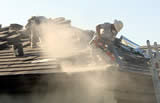| |
Do you think a health hazard exists in your
workplace? Do any of the following stories resemble situations at your
workplace?
- A factory worker was feeling numbness and tingling in her fingers.
She learned that three coworkers had the same problem, and two had headaches
while at work but not over the weekend. Some workers said the air at
work smelled bad. Their supervisor noticed the smell but didn’t
think it was anything to worry about.
 A
manager noticed that employees in one work area had more skin rashes
in the past year than the year before. He wanted to know why, but didn’t
know what to do. A
manager noticed that employees in one work area had more skin rashes
in the past year than the year before. He wanted to know why, but didn’t
know what to do.
- A work crew was putting cement tiles on a roof. They were working
outside, but the air seemed dusty. The saws used to cut the tiles were
noisy. Someone told them that this work was dangerous and they should
have it checked out.
At no cost to employers or employees, or their representatives, the NIOSH Health Hazard Evaluation (HHE) program may be able to help with problems like these. This site lets you know about the program and how to ask for NIOSH help. It also has links to reports from thousands of HHEs done by NIOSH.
New Health Hazard Evaluations
Evaluation of potential chemical exposures. The HHE Program responded to a request at a metal furniture manufacturing facility. The request concerned employees' potential exposure to welding fumes and dust from powder painting and grinding operations at the facility. HHE Program investigators took bulk samples of powder paint; sampled welders' exposure to metals, carbon monoxide, and nitrogen dioxide; sampled painters' exposure to 1, 3, 5-triglycidyl isocyanurate, titanium dioxide, and respirable and total dust; and interviewed employees. Investigators found that some welders were exposed to manganese and carbon monoxide above recommended levels. Investigators also found that some painters were exposed to 1, 3, 5-triglycidyl isocyanurate, and respirable and total dust above recommended levels. HHE Program investigators recommended that the facility use powder paints that do not contain 1, 3, 5-riglycidyl isocyanurate and welding wire that does not contain manganese. It was also recommended that spot cooling fans and exhaust fans be installed in the paint booth room to control heat stress, and exhaust fans in the welding area to remove welding fumes. HHE Program investigators also recommended that employees tell their supervisor about work-related health problems. The final report is available at http://www.cdc.gov/niosh/hhe/reports/pdfs/2007-0199-3075.pdf.
Evaluation of potential health hazards at a vehicle repair shop. The HHE Program responded to a request concerning employees’ exposure to diesel exhaust and asbestos-containing dust and cleaning solvents used during vehicle brake repair work. HHE Program investigators took bulk samples of brake dust and pieces of brake shoes to look for asbestos. Investigators also reviewed information on brake cleaners and washes used at the shop. Investigators determined that brake pads did not contain asbestos, but two brake cleaners being used contained tetrachloroethylene, a potential carcinogen. Investigators also found that one employee had possible work-related skin and throat irritation, and one had eye irritation. Fittings used to connect exhaust pipes and hoses were loose, contributing to poor ventilation in the shop. HHE Program investigators recommended that facility managers continue to use non-asbestos-containing brake shoes and pads, and discontinue the use of brake cleaners containing tetrachloroethylene. It was recommended that managers tighten connections between exhaust pipes and hoses, and connect hoses to exterior windows to improve shop ventilation. HHE Program investigators also recommended that employees use mild soap and water to clean hands, and moisturizing lotion to protect their skin. The final report is available at http://www.cdc.gov/niosh/hhe/reports/pdfs/2007-0055-3073.pdf.
 The free Adobe Acrobat Reader is needed to open a file on this page.
You can download Acrobat Reader from adobe.com
Learn More About the HHE Program
>>
Page last modified: March 30, 2009
Page last reviewed: February 12, 2009
Content Source: National Institute for Occupational Safety and Health (NIOSH)
|
 |
|

